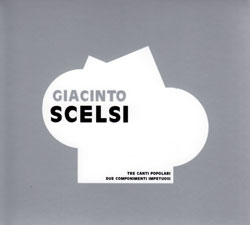
The world seems to be slowly catching up with the music of Giacinto Scelsi. Born into an aristocratic Italian family in 1905, Scelsi had no need to make a living from his compositions and did not seek the limelight during his lifetime. These proclivities caused him to be seen as a dilettante or dabbler, and his music was largely ignored. Perhaps also because of this, not much is known about Scelsi's life beyond a few bare facts. During the 1940's he suffered some kind of breakdown and as part of his therapy he would sit at the piano every day and listen intently as he played one note repeatedly, paying attention to the lingering overtones as the sound decayed. This practice then led him to compose music based on one note and it's overtones. He is now considered by many to be a precursor of the various kinds of modern contemplative music.
The two discs in this set bring together various works from different times during his life, but most are from the later years. Of the seven compositions on display, three are for voice, and three for piano, with the remainder being a piece for violin and cello.
"Tre Canti Popolari" for natural voice quartet has sweeping lines which rise and fall around each other, at times hovering to produce beautiful overtone groups, and at other times the overtones themselves seem to bend, an uncannily weird effect. "Wo Ma" songs for bass voice has strange verbalizations, whether in an actual language or just a device to produce different tonal and timbral effects I cannot tell, and they sound to my ears like operatic dada pronouncements. "Saun" for two female voices conjures up the most overtone information, using warbling vibrato. "Duo" for violin and cello sounds to the untrained ear like two string players tuning up, but is an exercise in overtone production and juxtaposition. And marvelously recorded I might add.
"Aitsi" for piano might well be sub-titled 'for distorted piano', as the keyboard here is amplified and mangled somewhat, giving us violent crashes of chord which decay into ghostly sonority.
The second disc gives us two piano pieces. "Sonate #4" from 1942 starts slowly and then builds up chordal and rhythmic information. At times it slightly resembles a slowed-down Cecil Taylor, and apparently Scelsi did compose many works by improvising into a tape recorder and then having his improvisations notated. The first section here ends with a short series of cloudy low-end chords, and the beginning of the second builds up from them slowly.
"Suite #11" begins with huge clashing clusters, and indeed the whole series here seems to be based around these violent, somewhat 'dissonant' chords, some dampened and some allowed to ring. This leads me to wonder if these pieces are indeed being played correctly, or if Scelsi ever considered using differently tuned pianos to bring out unique harmonies. I suppose we'll never know.
While this collection is perhaps not essential for learning about Giacinto Scelsi's music, it adds to the accumulating force of his voice and gives us another precedent for music to be listened to and not intellectualized.
Comments and Feedback:
| 


